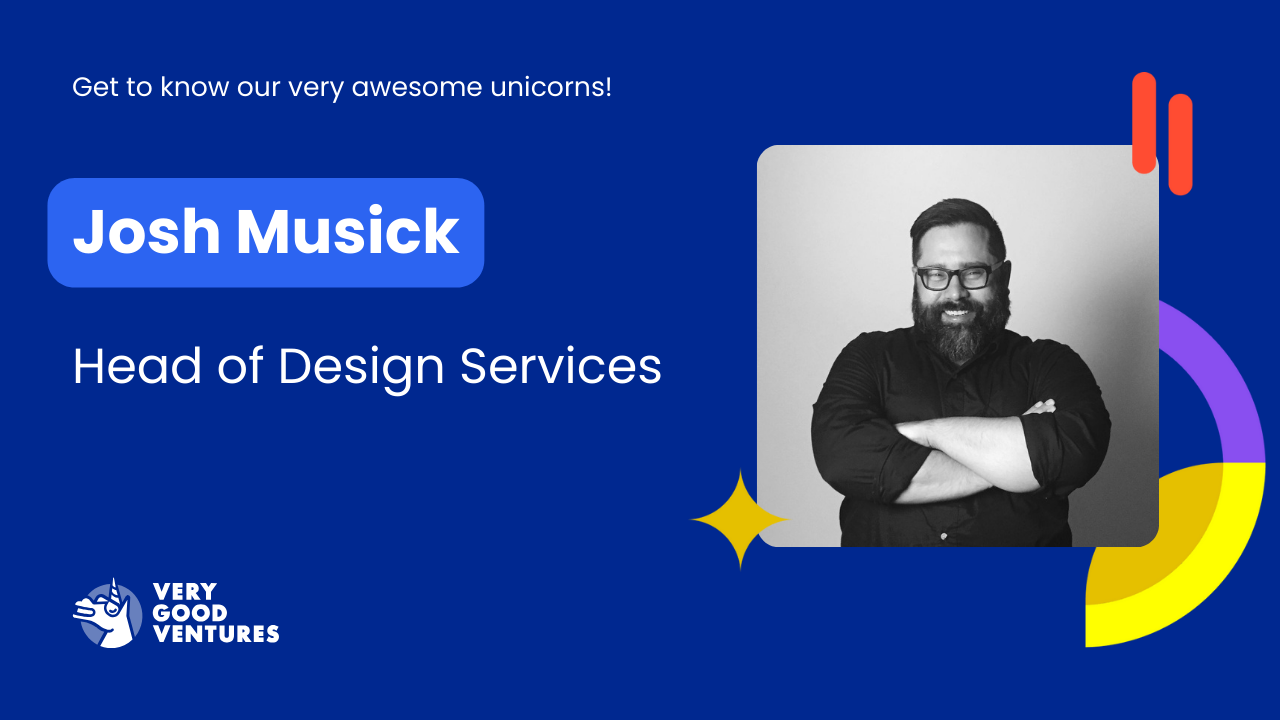Behind the Unicorn Magic: Get to know the VGV Team
Meet Josh Musick, VGV’s Head of Design Services

Josh's Background
J: I'm Josh Musick, Head of Design Services at VGV. Our primary focus is digital product design, with an emphasis on cross-platform and mobile applications.
I started working as a designer in the Web 1.0 era. Besides genuinely loving art and technology, I had an unexpected leg up in my entry into the profession in the form of a degree in philosophy. It gave me a strong foundation for working with abstract concepts and novel problem-solving, which were invaluable at a time when so much was still undefined about how technology might fit into our lives.
Throughout my career, I've had the opportunity to work on a diverse range of projects—web, mobile and desktop apps; enterprise-scale design systems, data platforms, hardware interfaces, and experience strategy—across a diverse array of verticals—fashion, media, e-commerce, finance, telecommunications, heavy industry, manufacturing, automotive, aerospace, building systems—for clients of all sizes—startups, NGOs, and SMBs and large enterprises. My experiences at frog and more recently, Raytheon Technologies, have equipped me with a broad skill set and a deep understanding of the intersection between design, technology, and business.
Role at VGV
J: My role at VGV is to lead the design team and make sure that the products we create meet the highest standards of quality and usability. We work hard to ensure that all of our designs can achieve user, business, and brand goals alike and that anything we create can be effectively used by our clients as their product grows over time.
I think what sets us apart from many competitors is our end-to-end approach. We’re a very good blend of a design consultancy like frog, where I worked for more than a decade, and a pure engineering services firm. Basically, we can handle any design problem from discovery and initial conception all the way through to product delivery.
How do you ensure VGV’s design process works for clients?
J: We try to keep our design process as user-centered as possible, but a thing that makes VGV different is the effort we put into client collaboration, which is at the heart of our design process at VGV. We work closely with cross-functional teams to ensure that our designs are strategically aligned and contribute to the overall success of our projects. We work hard to intimately understand what clients are trying to do and the constraints they’ve faced in trying to do it. We try to communicate as clearly as we can throughout the design process so that we’re certain we understand client objectives and the client understands how and why we’re making the decisions we are and the tensions we’re trying to resolve. This makes it more likely our designs are on target on the first pass and, if they’re not, subsequent feedback cycles are efficient and effective. All in all, it keeps us moving quickly.
Our ultimate goal is to build great products that users love and organizations can grow and manage effectively. I believe that, at its best, design can deliver experiences that make people smarter and more capable of doing what they want to do in the world. When design works well, it addresses real-world problems through clear hypotheses that can be validated with data. When we’re able to measure outcomes, we can know our designs work for users and actually deliver intended experiential and business results.
Can you describe a VGV project you're particularly proud of?
J: One project that stands out to me is the Flutter News Template. This project not only showcased our ability to deliver high-quality products rapidly but also had a significant impact on businesses worldwide. Seeing our work being used and appreciated by a diverse range of organizations is incredibly rewarding. We built something that was broadly extensible and usable by different kinds of businesses with various business models. On top of that, we did it the VGV way, really rapidly with consistently high-quality delivery.
I'm also proud of the collaborative nature of our work at VGV. We have the opportunity to work with a wide range of clients and industries, tackling complex design problems and making a positive impact on the world around us.
What challenges do you find in your day-to-day role, and how do you address them?
J: One of the most common challenges we face in our role is aligning client aspirations with the realities of product development. This often involves managing expectations and finding creative solutions to technical or resource needs. Building strong relationships with clients and understanding their unique needs is key to overcoming these challenges.
Another challenge is supporting teams with varying levels of design maturity. Some clients may have limited design resources or experience, which can lead to challenges in implementing design solutions effectively. Our approach involves providing support, guidance, and resources to help these teams succeed.
Are there any emerging technologies or trends you find particularly exciting?
J: There are two trends that I am particularly excited about: AI and low-code/no-code tools.
AI holds immense potential for revolutionizing the way we design and interact with digital products. From personalization to automation, AI-powered technologies can enhance user experiences in ways we never thought possible.
I’ve seen demos recently where the capabilities are astonishingly rich. It fundamentally changes what a software experience can do for a person. We are at the very beginning as well; a lot of very smart people are working very hard on core capabilities and the services that deliver them. It feels like the smartphone revolution all over again, I think we’ll completely reimagine our relationship with computing over the next 5-10 years.
AI also will dramatically impact how software is made, which is something VGV cares about a great deal. It’s why we’re also interested in low- and no-code tools. A lot of enterprise use cases require bespoke interfaces customized to a particular task. It’s just not sustainable to build all of these in a discrete one-by-one fashion. For designers, these are a logical extension of design systems. Like design systems, these tools are meant to democratize the design and development process and make it more accessible to teams of all sizes. How these tools unfold, where they get adoption, and the specifics of how they work are an area of great interest for the team.
Looking Forward
What aspirations do you have for the impact of your work at VGV in the future?
J: My first goal is to build a great team; and continue helping my teammates to become better designers and innovators.
For clients, I want to bring great products to market that smartly leverage emerging technologies, deliver key business results, and leave their users happy and productive. If we do things right, we have the opportunity to make a lasting impact on the industries we serve and the lives of the people who use those products.
For VGV more broadly, I’d like to continue accelerating the rate at which we can deliver dev-ready designs. We’ve developed a pretty extensive playbook of methods that really increase our velocity, and I want to continue expanding upon that work. We generally want to make the organization work better and better. Since our design team is somewhat new, not everyone in the company has an intuitive sense of our capabilities yet. I want everyone to understand the value Design brings to programs and to find synergies with our talented Engineering and Product teams to further optimize how we deliver.
I'm excited to see what the future holds as we continue to push the boundaries of design and technology.
Who is Josh beyond VGV?
- Josh is a dad, designer, creative leader and educator.
- He spent decades working in NYC at Organic, frog design, Raytheon Technologies’ Digital Accelerator in Brooklyn and teaching at the School of Visual Arts’ MFA Program in Interaction Design.
- He currently resides in Columbus Ohio with his wife and their two kids. He likes to cook for his family, usually listening to music, podcasts and standup comedy while he does it.
- At this point in his life, Josh is intensely boring and he feels pretty good about it.
Insights from Our Experts

How SoFi Scales Mobile Engineering with Flutter and AI
Lorem ipsum dolor sit amet, consectetur adipiscing elit. Suspendisse varius enim in eros elementum tristique. Duis cursus, mi quis viverra ornare, eros dolor interdum nulla, ut commodo diam libero vitae erat. Aenean faucibus nibh et justo cursus id rutrum lorem imperdiet. Nunc ut sem vitae risus tristique posuere.

Mastering CustomPainter in Flutter: From SVGs to Racetracks
Lorem ipsum dolor sit amet, consectetur adipiscing elit. Suspendisse varius enim in eros elementum tristique. Duis cursus, mi quis viverra ornare, eros dolor interdum nulla, ut commodo diam libero vitae erat. Aenean faucibus nibh et justo cursus id rutrum lorem imperdiet. Nunc ut sem vitae risus tristique posuere.
.png)
Inside Codemagic’s Rise: Flutter, Community, and the Future of Developer Tools
Lorem ipsum dolor sit amet, consectetur adipiscing elit. Suspendisse varius enim in eros elementum tristique. Duis cursus, mi quis viverra ornare, eros dolor interdum nulla, ut commodo diam libero vitae erat. Aenean faucibus nibh et justo cursus id rutrum lorem imperdiet. Nunc ut sem vitae risus tristique posuere.


